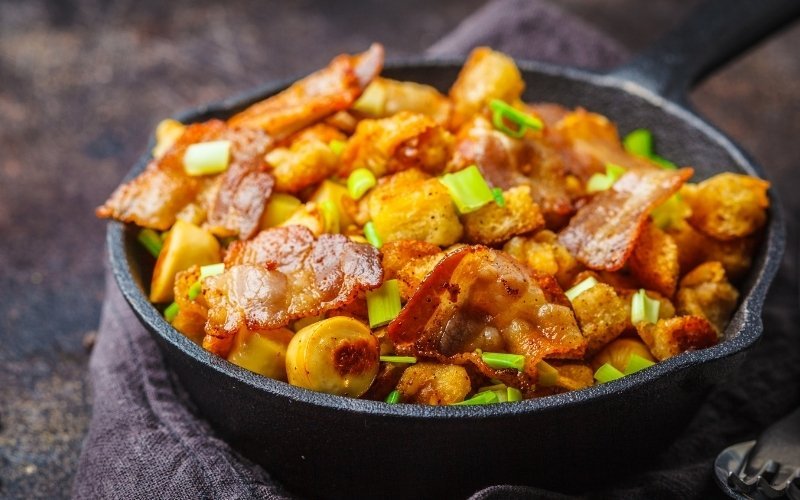When Gordon Ramsay uses a cast-iron skillet, there is no reason for you to doubt its benefits.
From excellent heat retention to providing a pitch-perfect sear on steaks and meat, a cast-iron pan can do it all!
But apart from the technically gifted nature of cast iron that makes it excellent cookware, it is also lauded by health and lifestyle enthusiasts for an entirely different reason. These experts claim that cooking in cast iron can have several health benefits! And, there is a significant amount of study and research going around this area of interest.
An interesting article in the Nepal Journal of Epidemiol flirted with the possibility of using cast-iron cookware to tackle the growing prevalence of iron deficiency in developing countries.
So, does a cast iron pan come with a two-fold set of advantages in the form of delicious food and improved health? If so, what is the science behind it?
In this article, we’ll verify the facts and bust the never-ending myths circling this issue.
Take our quiz at the end of the article to test your knowledge of cast iron cookware
Cast Iron and Its Relationship with our Health

Iron is an essential component required for blood production. Most of the iron content of our body is present in our red blood cells. They are crucial for the production of haemoglobin, which in turn, is responsible for the transfer of oxygen to and fro the different tissues in our bodies. A deficiency of iron in our bodies can have several health-related contingencies and disable us from carrying out normal bodily functions regularly.
There are widespread claims that the iron from your cast iron cookware can ooze into your food. Ultimately, this would increase the overall iron content of your food.
Thus, foods that otherwise have low iron content could be fortified with iron. And, it could be more beneficial if it is cooked in a cast-iron pan.
That sounds too good to be true, right? It just might be. Because now we’re going to find out if the claims are backed by science and research.
Related reading: Which type of cookware is the best for health?
Cast Iron Vs Iron Cookware: Difference, Similarities and More
Do the Claims have any Scientific Backing?

As we mentioned before, the claim is still subject to controversy in academic circles. There are many ongoing pieces of research trying to draw conclusive answers through data-driven and statistics-based analysis.
In general, the results are rather mixed. There is plenty of evidence to prove that iron is transferred to the food when it is cooked in cast iron. Certain studies have also shown an increase in haemoglobin and a decrease in Iron Deficiency Anaemia (IDA) when consuming food cooked in cast iron cookware. But, this doesn’t have any significant effect if the cause of anaemia is Malaria or hookworm.
A conclusive study published in the Journal of the American Dietetic Association states that the iron content of 100 gm of spaghetti sauce increase from a mere 0.6 mg to 5.7 mg when cooked in a cast-iron pot.
However, other studies claim that the quantity of the iron content transferred is small-almost negligible to have any noticeable effect.
Thus, it is fair to say that the health benefits of cooking in cast iron are still subject to debate as the amount of iron content transferred in your food can depend on a lot of factors.
Related reading: How To Season Cast Iron Cookware?
What are the Necessary Conditions to Draw Minerals from your Cast-Iron Pans?

It has been observed that acidic food leaches more iron. This is because acidic foods are corrosive. When they are in direct contact with the pan, they will strip some of its seasoning and transfer the iron to the food.
It is also noted that curries and stews with high moisture content and food that were cooked for a longer duration get a higher iron transfer.
Apart from the presence of an acidic commodity, other conditions too dictate the flow of iron into your food.
Some of them are:
- Your cast-iron pan shouldn’t be too seasoned. This is because your food needs to be in direct contact with the iron to leach into the food. Research has shown that newer pans transfer more iron compared to older well-seasoned ones.
- Foods need to be cooked at high heat for the transfer of iron content to take place.
- As cast-iron cookware takes longer to heat up, the food needs to be cooked for a relatively longer duration.
- Researches also say that iron content increases more in cooking meat than in vegetables and legumes. Scientists say this is possibly because non-heme iron in legumes has a lower degree of absorption than heme iron in meat.
And thus we derive a very important conclusion from the above points – you will need your food to be in direct contact with the pan (without any enamel coating) to transfer iron and other minerals from it. So the oil and fat build-up, also known as “seasoning”, will hinder the process of iron transfer. This is a huge blow as seasoning is an essential component for excellent searing and hassle-free cooking in a cast-iron pot. But I think we can’t get everything in life.
Related reading: Best Cast Iron Dosa Tawa In India
Conclusion
The verdict is out – and the jury states that while our body can absorb the iron content transferred from cast-iron cookware, there are several factors that affect the iron transfer from the cookware to the food.
So, while cooking in cast-iron pans can give you perfect searing, and it can have some kind of positive impact on your health, you cannot consider it as the primary source of iron for your body.
[HDquiz quiz = “14”]
